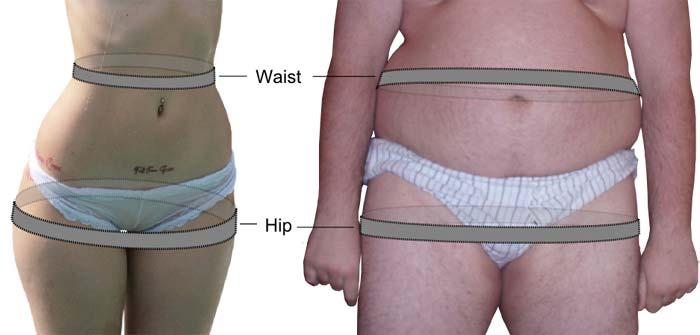Waist-to-Hip Ratio Calculator
- BMI Calculator
- BMR Calculator
- WHR Calculator
Disclaimer: The results given by this WHR calculator should be used only as a guide and should not replace medical advice. Please bear in mind that, when interpreting the results of this waist to hip ratio calculator, other factors such as muscle structure and ethnic origin should be considered. Always speak to a Doctor or health professional for advice before making any dramatic changes to your lifestyle.
What Is Waist-to-Hip Ratio?
The waist-to-hip ratio (WHR) is a quick and simple way to estimate how body fat is distributed, particularly around the abdomen—an area that surrounds many vital organs and is linked to greater health risks when excess fat accumulates there.
Experts use WHR measurements alongside other metrics such as BMI to estimate the amount and location of body fat. This combination of measures gives doctors an idea of how your body composition might affect your overall health and risk of disease.
How do you calculate your WHR?
To calculate your WHR you simply need to measure your waist and your hips, using a tape measure (or a length of string and a ruler), and then perform a simple calculation (or use our calculator at the top of the page). In order to get an accurate figure, it is important to make sure you take your measurements in the right place.
- Measuring your waist: use your tape measure to measure midway between your lowest rib and the top of your hips - it should be the part just above your belly button.
- Measuring your hips: measure at the widest point around the buttocks. Again, hold the tape snugly but don't pull it in, and make sure it's level all the way around.

Once you have your waist and hip measurements, simply divide your waist figure by your hip figure. Let's look at an example:
Example
- Waist measurement: 92cm (36.22 inches)
- Hip measurement: 112cm (44 inches)
To calculate your waist-to-hip ratio: 92 / 112 = 0.82.
What is the ideal waist-to-hip ratio?
The World Health Organization (WHO) suggests that keeping your waist-to-hip ratio (WHR) below certain thresholds may help reduce your risk of health problems. 1
- 0.85 or less for women
- 0.90 or less for men
The table below builds on these thresholds using categories commonly found in health resources like Healthline, to give a general idea of how different WHR values may relate to health risk. Bear in mind that these risk categories aren't universally agreed upon and may vary between health organisations.
| Female | Male | Health Risk |
|---|---|---|
| 0.80 or lower | 0.95 or lower | Low health risk |
| 0.81 to 0.85 | 0.96 to 1.0 | Moderate risk |
| 0.86 or higher | 1.0 or higher | High risk |
Understanding apple and pear body shapes
In our WHR calculator, we reference body shapes like apple, pear, and even avocado as a simple, illustrative way to explain how fat tends to be distributed in the body—and why that matters for your health. These labels aren’t medical classifications, but they offer an accessible framework for understanding risk. Let’s take a closer look at what each shape means.
People with pear-shaped bodies tend to carry more fat around their hips and thighs. This usually means a waist-to-hip ratio of 0.80 or below for women, and 0.95 or below for men.
Those with apple-shaped bodies carry more fat around the middle, with ratios of 0.86 or above for women and 1.0 or above for men. Fat stored around the abdomen is considered more harmful, as it surrounds vital organs and is linked to a higher risk of health problems like type 2 diabetes, heart disease, and some forms of cancer. 23
People whose ratios fall between these apple and pear thresholds are considered at moderate risk, and are sometimes—informally—described as having avocado-shaped bodies.
Final note
While WHR can provide helpful insight into fat distribution and associated health risks, it should not be used in isolation to diagnose medical conditions. Always consult a healthcare professional for a full assessment.
Calculator created by Alastair Hazell and reviewed by Aaron Kandola, Ph.D.References
- World Health Organization. Waist Circumference and Waist–Hip Ratio
- Healthline. Apple Body Shape: What It Means for Your Health
- Harvard Health Publishing. The link between abdominal fat and death: What is the shape of health?
If you have any questions about this calculator then please contact me.
